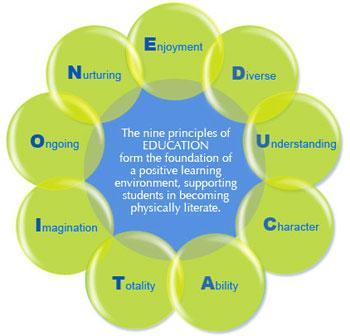Educators play an important role in establishing physical literacy among students.
The interactive wheel to the right outlines the nine principles of physical literacy which are based upon the acronym EDUCATION, and are consistent with a Quality Daily Physical Education program which is a key element of success. They also form a foundation to create a positive learning environment which supports students in becoming physically literate.

The EDUCATION acronym allows you to navigate through various pedagogical strategies, enhanced by podcasts, research papers, resources and activity ideas, that can help teachers foster the development of physically literate students
Enjoyment
Pedagogical strategies to help foster ENJOYMENT:
- Intrinsically motivate students by providing students with choice and skill development.
- Optimally challenge students where the challenge of an activity matches their skill level and encourages them to improve and succeed.
- Provide developmentally appropriate student-centered classes.
- Provide a high level of participation by all students in each class.
You can learn more about fostering ENJOYMENT by viewing the video.
Diverse
Pedagogical strategies to foster DIVERSE forms of activity:
- Ask ALL students to identify the types of activities they would like to learn.
- Use a wide range of forms of physical activity throughout the year (e.g., dance, gymnastics, games, fitness, and outdoor pursuits).
- Include both traditional and non-traditional forms of physical activity.
- Include activities that promote cultural understanding and awareness.
- Use diverse forms of teaching styles to suit individual needs and multiple objectives
Find out more about fostering DIVERSITY by viewing the video.
Understanding
Pedagogical strategies to foster UNDERSTANDING:
- Create well planned lessons that ensure all activities are linked to achieving curricular expectations and/or outcomes.
- Encourage deeper forms of understanding that go beyond simple knowledge.
- Encourage various forms of communicating knowledge, analyzing movement, and applying movement and its principles across and within a wide variety of physical activities.
- Encourage students to be “intelligent movers.”
You can learn more about fostering UNDERSTANDING by viewing the video.
Character
Pedagogical strategies to foster CHARACTER:
- Ensure key character traits such as fair play, cooperation, and teamwork are reinforced through physical activities.
- Infuse the development of life skills in all physical activities. For example, through physical activities, students can learn critical life skills such as cooperation, positive communication, leadership, personal and social management, decision making, problem solving, conflict resolution, stress management, interpersonal skills, spiritual and moral development.
You can learn more about fostering CHARACTER by viewing the video.
Ability
Pedagogical strategies to foster ABILITY:
- Encourage individual improvement and avoid comparisons to others.
- Foster the development of a wide variety of fundamental skills in order for students to develop movement competence. These skills in turn form the foundation for more complex movement skills in advanced grades. The transfer of these skills is encouraged in order to facilitate competence across a wide variety of physical activities.
- Provide refining cues to enable learners to improve their motor skills.
You can learn more about fostering ABILITY by viewing the videos:
part 1 and part 2.
Totality
Pedagogical strategies to foster TOTALITY:
- Provide students with opportunities to develop total body fitness. This includes providing a wide range of fitness activities that support the development of endurance, strength, and flexibility.
You can learn more about fostering TOTALITY by viewing the video.
Imagination
Pedagogical strategies to foster IMAGINATION:
- Ensure creative and safe use of facilities and equipment.
- Encourage individuals or groups to generate creative solutions to various movement challenges. This can come in the form of creativity in a dance or a gymnastics sequence; strategic thinking during a game or an outdoor pursuit activity, or innovation in designing a personal fitness program
You can learn more about fostering IMAGINATION by viewing the video.
Ongoing
Pedagogical strategies to foster ONGOING:
- Ensure physical education is offered on a regular (preferably daily) basis.
- Emphasize the importance of active living and the acquisition of the skills, knowledge, and attitudes that students need to make ongoing healthy choices now and throughout their lifespan. – Include physical activities that can be done throughout the lifespan.
- Provide participation based intramural programs that enable students to apply their skills from physical education.
- Identify areas of the community where students can be active outside of school (e.g., parks, trails, swimming pools, local sport clubs, etc).
You can learn more about fostering ONGOING by viewing the video.
Nurturing
Pedagogical strategies to foster NURTURING:
- Ensure the whole child is nurtured: physical development (e.g., fitness, skill development), cognitive development (e.g., thinking, understanding, problem solving skills), and affective development (e.g., positive peer interactions, communication, spiritual, teamwork, cooperation).
- Plan appropriate activities for the age and stage of each student.
You can learn more about fostering NURTURING by viewing the video.
